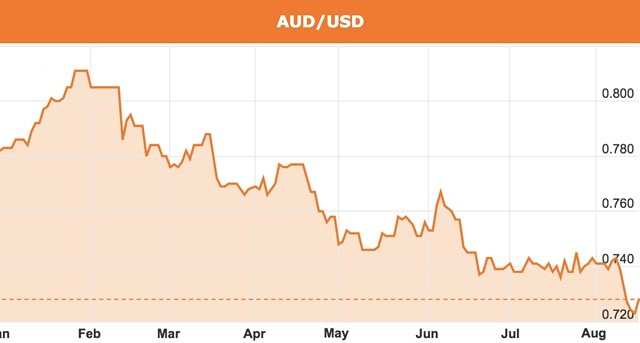Australian dollar getting hit by tariff war

The Australian dollar has fallen 9% in the past six months.
If there is an “innocent’’ victim of increasing trade and political tensions, the Australian dollar has got to be it.
Despite our consistent 27 year run of economic growth, the Australian dollar has been crunched 9 per cent over the past six months as it becomes an easily tradeable and highly liquid proxy for China.
That is probably understandable given Australia’s strong links to China through iron ore and coal exports but it does seem a little odd that our currency is hit so hard by the tariff war when Australia itself is one of the rare countries to escape direct tariffs -so far.
The fact that Australia is so small in world terms and is highly leveraged to trade with China, which makes up a third of our exports, has turned the Australian dollar into a China proxy even if we are moving towards a balanced budget and are not part of the trade war ourselves.
Fall could go all the way to US60c
The fall in the Australian dollar so far could just be the beginning according to some traders, with rising US interest rates sure to continue to lure hot money looking for a high and safe yield in that direction and away from Australia.
Australia’s Reserve Bank Governor, Philip Lowe, has made no move to raise official interest rates from their two year levels of 1.5 per cent even as there has been a global move up in official interest rates, led by the US Federal Reserve.
Lower dollar good for some
In general terms, a lower US dollar is great news for mineral and rural exporters because it increases their returns for a given amount of product which is usually priced in US dollars.
However, imported goods become more expensive with a lower currency so inflation could begin to tick upwards with a lower dollar, potentially even pushing up domestic interest rates as well.
A lower dollar is also bad news for international travellers who get less foreign currency for their money but can be good for domestic Australian tourism, as locals and overseas visitors alike flock to a “cheaper’’ destination.
Aussie is a proxy for risk
The other factor operating against the Australian dollar is that it is seen as a proxy for risk.
If things start to look risky in the world, traders sell the Australian dollar while if there are unexpected breakthroughs, the Australian dollar can rise.
That is worth keeping in mind as the US and China continue sporadic talks as the next round of tariffs move closer, with any positive news likely to be reflected in a stronger dollar and any failures likely to push the dollar lower still.

